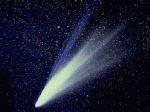

Meteors have about ten different named to describe them – most of which are used to describe a rather specific attribute of the same object. Between bolides’ blowing up all over the place, fireballs streaking through the sky, new comets passing like there’s no tomorrow, and cool meteorites being discovered left and right, I thought it prudent to describe what these objects are.

Credit: Observatoire de Haute, Provence, France
Comets:
Comets are the sexy brother/sister of asteroids. Everybody loves them and can’t wait to check them out in their full glory. The defining characteristic for comets is the corona and resulting comet tail that’s created as layers of dust and ice evaporate due to energy coming from the Sun. Debris from comet tails are responsible for the annual Meteor showers that we enjoy.
Asteroids:
We’ve had a few ‘close calls’ with extinction-sized asteroids this year. Asteroids, also known as planetoids, are objects that orbit the sun, too small to be a dwarf planet, but large enough to get their own designation. Asteroids are in space, when they start interacting with the atmosphere of a planet, their name starts to change. In my personal opinion, asteroids pose one of the greatest natural threats to life on Earth.
Meteoroids:
These are rocks, orbiting the sun, smaller than asteroids (basically, anything smaller than 10-meters). They are extremely dangerous to equipment in orbit, and many of them burn up in Earth’s atmosphere on entry. For the most part, every meteor shower that has ever visited Earth has been composed of meteoroids.

Meteors:
When en asteroid/meteoroid enters Earth’s atmosphere, it becomes a meteor (also known as a shooting star). Friction from Earth’s atmosphere causes most meteors to burn up, protecting the life below and producing a cool show in the process.
Fireballs:
If a meteor is ‘unusually bright’ it undergoes a name change and becomes a fireball. Fireballs have an apparent magnitude comparable to Venus and are much brighter (and rarer) than your regular meteors. For the most part, a fireball is caused simply by friction from Earth’s atmosphere – it’s just a bigger rock so it burns brighter.

Bolides:
A bolide is a fireball that explodes in midair. Bolides are particularly famous this year with the one that exploded over Russia a few months ago, as well as a few other less-spectacular ones. They have prompted governments to take space-based natural threats more seriously which is only a plus. It’s thought that gasses inside large meteors are heated very quickly over a short period of time, causing those gasses to rapidly expand. Of course, rapidly expanding gasses inside a solid object causes a big boom. It is important to note that there isn’t really an official definition for what constitutes a bolide. The explosion factor tends to be a common theme, but sometimes astronomers use the term to describe exceptionally bright fireballs (-14 magnitude or brighter – which is brighter than the full moon) or any crater-forming impacting body.
Meteorite:
For those meteors, fireballs, bolides, or fragments there of that survive the trip through the atmosphere and impact the Earth, they become meteorites. A meteorite is basically any non-terrestrial rock that has come for a visit. There are different types of meteorites such as lunar meteorites, Martian meteorites, or other meteorites originating from different places in the solar system. Scientists are able to determine the origin of a meteorite using different methods, such as looking at radioactivity or composition.
There are, of course, a large number of sub-groups to the main objects I mentioned here, but that’s the general overview of terminology. So, the next meteor shower you’re watching, kick back with a beer and enjoy. Who knows, you might be able to teach your mates a thing or two about the objects you watch burning up in the atmosphere.